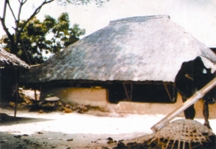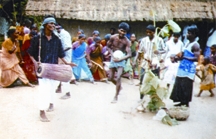Oraon, The
Oraon, The an ethnic community of Bangladesh mainly living in the varendra region. According to the anthropologists, they are Austric as a race and linguistically Dravidians. Hence most of the researchers identify the Oraons as the descendants of Dravid-speaking Kurukha race. The Census Report of 1881 reveals that the Oraon also used to live in the districts of mymensingh, chittagong and noakhali.

There is no specific evidence on when and on what background the Oraon people migrated to Varendra region in Bangladesh from their ancestral home in India. It can only be assumed that they penetrated in into the Varendra region during the Mughal period and permanently settled there.
The Census Report of 1991 recorded the number of Oraons in Bangladesh as 11,296. But presently the number has rose to 102,000. They now live mostly in the districts of Kurigram, Nilpharmari, Gaibandha, Lalmonirhat, Rangpur, Dinajpur, Joypurhat, Bogra, Rajshahi, Naogaon, Natore, Chapai Nawabganj, Gazipur, Habiganj and Maulavibazar.
Oraons worship natural objects. They believe that there is a creator of the universe named Dharami or Dharmesh or Dhormesh, who exists in the sun. Under this concept, they also consider the sun as a god. Oraons offer worship to their creator Dharmesh to keep him satisfied. They also celebrate 'Dandakanta' festival dedicated to him. Oraons belief in the existence of evil spirits including the souls of their dead ancestors and offers worship to the evil sprits to make them pleased. Influenced by Hindu religion, them also worship the goddess Laksmi and Saraswati. The Oraons decorate their body with tattoo. Tattooing is considered as a religious ritual for every Oraon boys and girls before attaining adulthood. They believe that god will be angry upon dying without having tattoos on their body and shall be thrown to eternal hell.

Oraons are divided in many tribes like Lakra, Tigagya, Teerki, Bindo, Bado or Badoa, Khan Khan, Karketa, Topya, Ekka, Khalko, Linda, Minji, Bakla, Bara, Kshes, Gunna, Bek and Kispotta. Oraons consider all the people of a tribe belonging to the same family and consider themselves as brothers and sisters. So intra-tribe marriages are not allowed in the Oraon society.
There is an organisation in every Oraon village called Panches to maintain law and order and to mitigate other internal and conflicting issues. Panches is comprised of seven to eight senior members of the village. The tenure of each Panches is three to five years. If any judgment cannot satisfy any complainant, he or she may go for appeal to a higher body called Pnarha.
The mother tongue of Oraons is Kuruk. It does not have alphabets, but Oraons have a traditional oral literature. The Oraon society is divided into the upper and lower clans on the basis of different dialects Kuruk and Shadri.
Traditional dresses of Oraon were earlier very short. Male used to wear a single cloth called nengti and women had an additional piece of small cloth called fata to cover the top of the body. But now Oraon males wear lungi and dhuti as well as shirt or punjabi. The educated Oraon boys and girls wear shirt-pant and salwar-kamij, sari respectively. Oraon women like to wear ornaments of different designs like karma shikri (ornamented nose-pin), paira (ornamented attires), muddies (to decorate foot-fingers) and khangsho (a hair clip made of silver) etc.
Rice is the staple food of the Oraons. They also take meat of animals and birds, fruits found in the jungle, different types of fish available in rivers, canals, and ponds and other water bodies. Beef, mutton, buffalo meat, lamb, pork, chicken and meat of rabbit, moggies, porcupine, squirrel, and chameleon are their very favourite food. Moreover, they eat oyster, crab, eel, turtle and scorpion. Egg is also included in their menu. Offering hard drink to guests and enjoying it in festival and functions is an integral part of the traditional Oraon hospitality.
Oraons live in very small huts having clay-wall and flaxen roof. Most of the houses have thatched roof, consisting of four parts with a veranda. But the height of the door is so short that none can enter without bending down his or her head. But the huts are very clean, walls are smeared and sometime lower parts are painted with natural objects like tree, creepers and herbs, birds, flower etc are designed on walls with various bright colours.
Dance and music are integral parts of Oraon culture. They make their traditional musical instruments including dhol, madal, flute, tal, magra, khaujani, ghutur by themselves and play on them during religious ceremonies and festivals. Nowadays Oraons have started playing harmonium. They celebrate the major festivals like sarhool, karam, paus utsab, khariani, faguna and sohrai.
Marriage rituals in the Oraon community are based on customs practices. In Oraon culture, both contact and love marriages are accepted. However, the guardians arrange most of the marriages after taking consent of the bride and bridegroom. When bride attains twelve years of age marriages are solemnised with bridegroom of eighteen to twenty two years. This is a very usual practice, but there are exceptions. Widows can re-marry in this society and divorce on specific ground is also allowed.
Oraons believe in the doctrine of re-birth and for that reason they perform some rituals for the salvation of departed souls. Earlier they used to burn dead body. They also followed the custom of burial in the ground. Recently the convention of burial is preferred over cremation perhaps due to high price of firewoods.
Like Hindus Oraons follow the ritual of pindidan. They offer food to observe the formalities on the third, fifth, seventh, eleventh or thirteenth day of death of the deceased.
The believer in Christianity is on the increase among the Oraon community. The literacy rate is on the increasing among the Oraons accepting Christianity and that was mainly due to the activities of the missionaries. Their dress, behaviour and language are being greatly influenced by the mainstream culture of the Bangalis. [Majharul Islam Taru]
